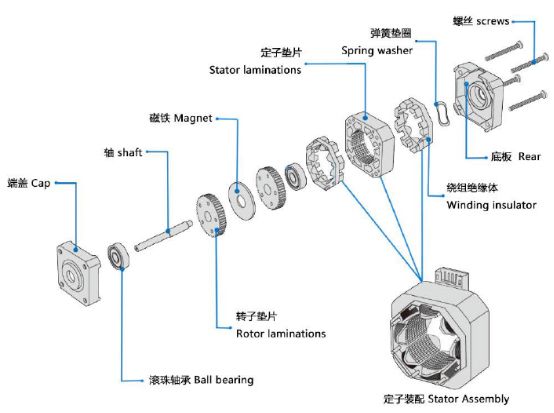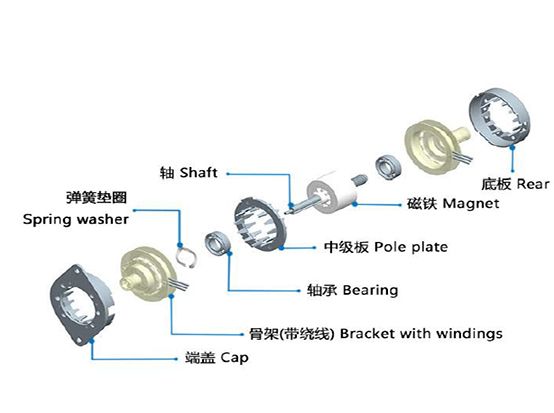Princip stvaranja toplinekoračni motor.

1, obično vidim sve vrste motora, unutarnji su željezna jezgra i zavojnica namota.Namot ima otpor, pod naponom će proizvesti gubitke, veličina gubitka proporcionalna je kvadratu otpora i struje, što se često naziva gubitkom u bakru. Ako struja nije standardnog istosmjernog ili sinusnog vala, također će proizvesti harmonijske gubitke; jezgra ima histerezni efekt vrtložnih struja, u izmjeničnom magnetskom polju također će proizvesti gubitke zbog svoje veličine i materijala, struje, frekvencije i napona, što se naziva gubitkom u željezu. Gubitak u bakru i željezu očituje se u obliku topline, što utječe na učinkovitost motora. Koračni motori općenito teže točnom pozicioniranju i izlaznom momentu, učinkovitost je relativno niska, struja je općenito relativno velika i ima visoke harmonijske komponente. Frekvencija izmjene struje također varira s brzinom, pa se koračni motori općenito zagrijavaju, a situacija je ozbiljnija od općeg AC motora.
2, razuman rasponkoračni motortoplina.
Dopuštena razina zagrijavanja motora uglavnom ovisi o razini unutarnje izolacije motora. Performanse unutarnje izolacije na visokim temperaturama (130 stupnjeva ili više) prije nego što se uništi. Dakle, sve dok unutarnja temperatura ne prelazi 130 stupnjeva, motor neće izgubiti prsten, a površinska temperatura će u ovom trenutku biti ispod 90 stupnjeva.
Stoga je temperatura površine koračnog motora normalna između 70-80 stupnjeva. Jednostavna metoda mjerenja temperature korisna je točkastim termometrom, a možete je i otprilike odrediti: ako rukom dodirnete temperaturu dulje od 1-2 sekunde, ne više od 60 stupnjeva; ako rukom dodirnete samo oko 70-80 stupnjeva; ako nekoliko kapi vode brzo ispari, temperatura je veća od 90 stupnjeva.
3, koračni motorzagrijavanje s promjenama brzine.
Prilikom korištenja tehnologije pogona konstantnom strujom, koračni motori pri statičnoj i maloj brzini, struja će ostati konstantna kako bi se održao konstantan izlazni moment. Kada je brzina visoka do određene razine, unutarnji protupotencijal motora raste, struja će postupno padati, a okretni moment će također padati.
Stoga će uvjeti zagrijavanja zbog gubitka bakra ovisiti o brzini. Statička i niska brzina općenito generiraju veliku toplinu, dok velika brzina generira malu toplinu. Međutim, gubici željeza (iako manji udio) se ne mijenjaju, a toplina motora u cjelini je zbroj ta dva, tako da je gore navedeno samo opća situacija.
4, utjecaj topline.
Iako toplina motora općenito ne utječe na vijek trajanja motora, većina kupaca ne treba tome posvećivati pozornost. Međutim, to može imati ozbiljne negativne učinke. Na primjer, različiti koeficijenti toplinskog širenja unutarnjih dijelova motora dovode do promjena u strukturnom naprezanju, a male promjene u unutarnjem zračnom rasporu utjecat će na dinamički odziv motora, te će se pri velikim brzinama lako izgubiti tempo. Drugi primjer su neke situacije koje ne dopuštaju prekomjerno zagrijavanje motora, poput medicinske opreme i visokoprecizne ispitne opreme itd. Stoga je potrebno kontrolirati toplinu motora.
5, kako smanjiti toplinu motora.
Smanjenje stvaranja topline znači smanjenje gubitka bakra i željeza. Smanjenje gubitka bakra u dva smjera smanjuje otpor i struju, što zahtijeva odabir što manjeg otpora i nazivne struje motora. Kod dvofaznog motora motor se može koristiti serijski, a ne paralelno. Međutim, to često proturječi zahtjevima za okretni moment i veliku brzinu. Za odabrani motor, treba u potpunosti iskoristiti funkciju automatske kontrole pola struje i offline funkciju pogona. Prva automatski smanjuje struju kada je motor u mirovanju, a druga jednostavno isključuje struju.
Osim toga, kod podjele pogona, budući da je oblik vala struje blizu sinusoidnog, s manje harmonika, zagrijavanje motora također će biti manje. Postoji nekoliko načina za smanjenje gubitaka željeza, a razina napona je povezana s tim. Iako će motor pokretan visokim naponom donijeti povećanje karakteristika velike brzine, on također donosi povećanje stvaranja topline. Stoga bismo trebali odabrati pravu razinu napona pogona, uzimajući u obzir veliku brzinu, glatkoću i toplinu, buku i druge pokazatelje.
Tehnike upravljanja procesima ubrzanja i usporavanja koračnih motora.
S široko rasprostranjenom upotrebom koračnih motora, sve je veća i potreba za proučavanjem upravljanja koračnim motorima. Pri pokretanju ili ubrzanju, ako se impuls koračnog motora prebrzo mijenja, rotor zbog inercije ne prati promjene električnog signala, što rezultira blokiranjem ili gubitkom koraka. Pri zaustavljanju ili usporavanju iz istog razloga može doći do prekoračenja. Kako bi se spriječilo blokiranje, gubitak koraka i prekoračenje, potrebno je poboljšati radnu frekvenciju koračnog motora kako bi se povećala brzina upravljanja.
Brzina koračnog motora ovisi o frekvenciji impulsa, broju zubaca rotora i broju otkucaja. Njegova kutna brzina proporcionalna je frekvenciji impulsa i sinkronizirana je s impulsom. Dakle, ako su broj zubaca rotora i broj radnih otkucaja određeni, željena brzina može se postići kontroliranjem frekvencije impulsa. Budući da se koračni motor pokreće uz pomoć sinkronog momenta, početna frekvencija nije visoka kako se ne bi izgubio takt. Pogotovo kako se snaga povećava, promjer rotora povećava, inercija se povećava, a početna frekvencija i maksimalna radna frekvencija mogu se razlikovati i do deset puta.
Početne frekvencijske karakteristike koračnog motora su takve da se koračni motor ne može izravno pokrenuti i dosegnuti radnu frekvenciju, već se mora provesti proces pokretanja, odnosno postupno povećavati brzinu s niske na radnu brzinu. Zaustavljanje se događa kada se radna frekvencija ne može odmah smanjiti na nulu, već se brzina mora postupno smanjivati na nulu pri velikoj brzini.
Izlazni moment koračnog motora smanjuje se s porastom frekvencije impulsa. Što je veća početna frekvencija, to je manji početni moment i slabija je sposobnost pokretanja opterećenja. Pri pokretanju će doći do gubitka koraka, a pri zaustavljanju će doći do prekoračenja. Da bi koračni motor brzo dosegao potrebnu brzinu, a da ne izgubi korak ili prekoračenje, ključno je ubrzati proces ubrzanja, pri čemu moment ubrzanja mora u potpunosti iskoristiti moment koji koračni motor osigurava na svakoj radnoj frekvenciji i ne smije se prekoračiti. Stoga, rad koračnog motora općenito mora proći kroz tri faze: ubrzanje, jednoliku brzinu i usporavanje, vrijeme ubrzanja i usporavanja treba biti što kraće, a vrijeme konstantne brzine što dulje. Posebno kod radova koji zahtijevaju brz odziv, vrijeme rada od početne do krajnje točke mora biti što kraće, što zahtijeva ubrzanje i usporavanje, a najveća brzina mora biti konstantna.
Znanstvenici i tehničari u zemlji i inozemstvu proveli su mnogo istraživanja o tehnologiji regulacije brzine koračnih motora i uspostavili razne matematičke modele za regulaciju ubrzanja i usporavanja, kao što su eksponencijalni model, linearni model itd. Na temelju toga, dizajnirani su i razvijeni različiti upravljački krugovi za poboljšanje karakteristika gibanja koračnih motora i proširenje raspona primjene koračnih motora. Eksponencijalno ubrzanje i usporavanje uzima u obzir inherentne karakteristike momenta i frekvencije koračnih motora. To osigurava da se koračni motor kreće bez gubitka koraka, ali i da se u potpunosti iskoriste inherentne karakteristike motora i skrati vrijeme podizanja. Međutim, zbog promjena opterećenja motora to je teško postići. Linearno ubrzanje i usporavanje uzimaju u obzir samo kutnu brzinu motora u rasponu nosivosti i puls proporcionalan tom odnosu. Ne uzimajući u obzir fluktuacije napona napajanja, opterećenja i promjene karakteristika, ova metoda ubrzanja je konstantna. Nedostatak je što ne uzima u potpunosti u obzir izlazni moment koračnog motora. S obzirom na karakteristike promjene brzine, koračni motor će se pri velikoj brzini ponašati neusklađeno.
Ovo je uvod u princip zagrijavanja i tehnologiju upravljanja procesom ubrzanja/usporavanja koračnih motora.
Ako želite komunicirati i surađivati s nama, slobodno nas kontaktirajte!
Usko surađujemo s našim kupcima, slušamo njihove potrebe i djelujemo na njihove zahtjeve. Vjerujemo da se obostrano korisno partnerstvo temelji na kvaliteti proizvoda i korisničkoj službi.
Vrijeme objave: 27. travnja 2023.

